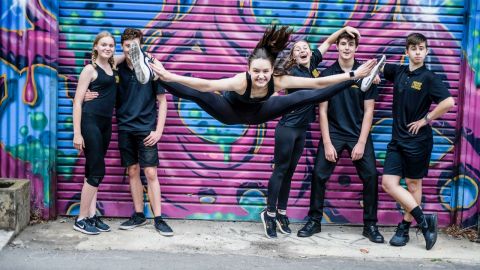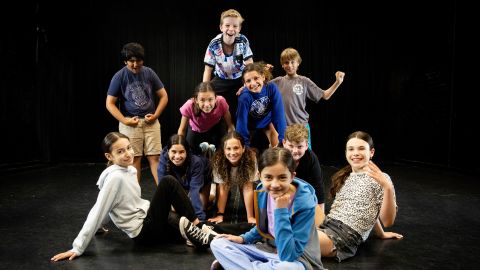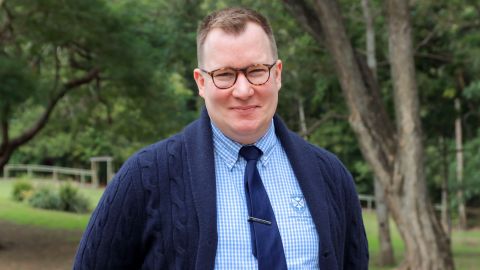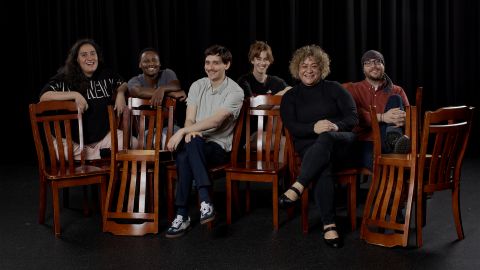From Russia With Love

Oleg Glushkov brings the world of Chekhov to NIDA
NIDA is continuing a partnership with the Russian Institute of Theatre Arts (GITIS), Russia’s oldest and largest theatre school. GITIS graduate and teacher Oleg Glushkov has been at NIDA for a week-long placement to work with Year 2 Acting students in preparation for their October 2018 production season, when he will return.
Oleg Glushkov is a contemporary Russian choreographer and movement director, experienced in theatre, musical theatre, including Broadway productions, and film.
What recent projects have you choreographed? Both in Russia and also outside of Russia? I understand you have recently worked on Broadway?
In Russia I am working in Moscow on a production of Anna Karenina that is set to open in September.
I’m also choreographing a Broadway musical, Hipsters, an adaptation of a famous Russian movie, set in the 1950s, about two small groups of teenagers in Moscow and St Petersburg. It focuses on how they were inspired by American culture: music, fashion, etc. – at a time when that was forbidden in Russia and was actually illegal. If they caught someone with hair styled in a particular way, for example, they could have gone to jail. Russian songs feature heavily in the movie, created by independent bands who were making rock songs that weren’t supported by the Government at the time. All these songs are being adapted and arranged for this new musical, which is pretty big. It’s also an interesting time for this particular production because of the relations between Russia and the US.
How important do you think movement is in a play or musical?
Every director has to decide on the importance of movement for themselves. If you want to create a performance you need to create a new language, but there are no rules with regards to using movement. I know that for some directors the exactness of movement is not important because what matters to them are ideas, words and written words. On the other hand you have directors who use movement for expression with unusual, artificial movement. And some directors work with ordinary movement but make it very precise, using very fine and choreographed positions. I also know directors who make a lot of performances, say two a year, but it looks like one huge long performance. They change the names of the plays but it continues as one long performance which is cool as well.
For me, movement as a language is very important. It’s about images that can be created on stage when we see ‘freeze positions’ and using certain lights – for instance a drop of water, somebody playing the violin and somebody drinking tea. Imagine a person moving slowly, drinking a cup of tea, building suspense, and then somebody drops from the roof and smack… we move onto the next part. These are the kind of images I’m talking about.
What are the different ways Chekhov is handled in contemporary practice in Russia?
When Chekhov was staged in his time and a little after his death, it was a really important time in theatre. It was all about the ordinary, middle class people of Russia and the problems that these people faced with things like money, love and ageing.
Chekhov went further. His theatre was so close to real life, it was very important for him to feel and focus on things like the wetness in the air, right down to a grain of rice and other objects that don’t look important, but come together to make theatre.
For many years in Russia, Chekhov was performed as an example of really precise existence on stage, reality with real feeling, something that was far from empty. Nowadays directors are approaching Chekov plays differently using new methods and trying to deconstruct it away from the focus on the people and the costumes and how they are walking. They try to see Chekhov from a new view which is what I find interesting. Chekhov was like a Russian treasure and everyone was really careful about the treasure, careful not to touch it for fear of ruining it. Now it’s more acceptable to change it and place contemporary practice around it.
 What are your impressions of NIDA and how does it compare to similar schools in Russia?
What are your impressions of NIDA and how does it compare to similar schools in Russia?
This is the first time I have been to Australia and it is the first time I have intersected with NIDA, since I met Egil Kipste and Michael Scott-Mitchell in Moscow when they came to talk about a potential educational exchange.
I am excited to be here and I am really surprised that the people at NIDA are so warm, it’s a very warm atmosphere. NIDA is smaller than GITIS which has three large buildings and where you don’t know who everyone is. The facilities here at NIDA are very good to work with.
In Moscow at GITIS I work with younger students, and also in Russia the undergraduates don’t have to pay for their courses. This has benefits – the students are young and open to ideas, and they are free to choose their courses.
On the other hand, here at NIDA the older students are a little more confident in their ability and as they are paying for their education they are very focused in the time that they have with me. They don’t want to waste time.
When I came to NIDA to work with the students I was afraid that my personal Russian background would be so completely different to the Australian students that we would find it difficult to connect. My childhood is so different to theirs and a lot of our performance practice is based on our own personal history. And of course there is language barriers as well.
But this has not been the case. We can joke and have fun with each other. What is fun for me is fun for them as well! Not everything however! For example we did one exercise based on slow dancing in couples. I was using the example of a disco, when at the end of the night everything slows down and there are just a few couples left on the dance floor together getting, close. And they really didn’t know what that was. They don’t dance slow. Maybe that is a generation thing?
Which production will you be directing/choreographing at NIDA later this year?
I will be collaborating on a Chekhov piece that is devised with the students in all the stages of the production. I’m interested in sharing the responsibility of performance making with the students.
My rehearsal process includes exploring scene work and group scenes with props and costumes an integral part of the process from the beginning.
I am working around the Chekhovian world, using Chekhov action and material and his four plays, Uncle Vanya, The Seagull, Three Sisters, and Ivanov. We are using all these plays but are working with them like a collage.
How will you approach it?
We are not working on one play – although it is an absolute necessity for the students to know about his plays. We cut up the Chekhovian world into small pieces and mash it up into an experience which includes a lot of movement and images.
Chekhov is a very precise and detailed author, and at first it seems that the action is accidentally phrased. But it is not – it is very complicated material and very dense. Each small phrase or sentence about daily life has a lot of power. It’s very different to Brecht or Shakespeare.
I would also like them to take part and play musical instruments in the pieces – in the Chekhovian world the plays take part in the countryside with people not doing anything. But they create performances within that, like in The Seagull, where someone sings or plays an instrument. So I would like the students to express this live music, which as actors they will play like ordinary people, as they are not musicians.





